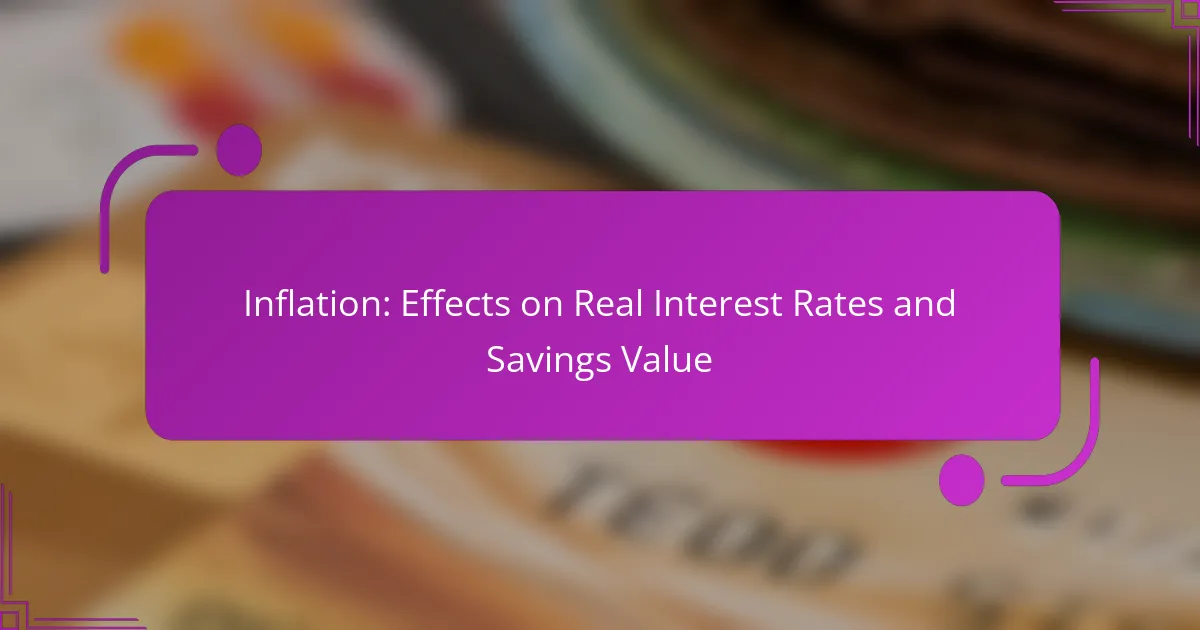Inflation significantly impacts real interest rates and the value of savings by diminishing purchasing power. As inflation increases, nominal interest rates often fail to keep pace, leading to lower real interest rates and reduced returns on savings accounts. This erosion of value necessitates strategic financial planning to protect savings and maintain their purchasing power in an inflationary environment.
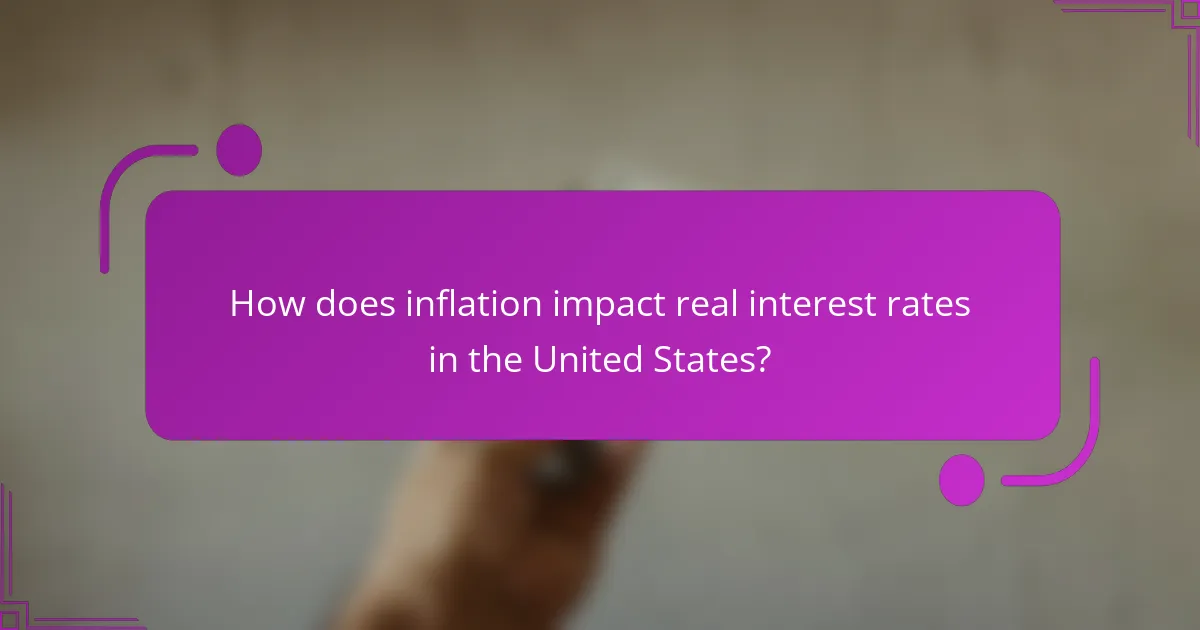
How does inflation impact real interest rates in the United States?
Inflation affects real interest rates by eroding the purchasing power of money, which can lead to lower real interest rates. When inflation rises, the nominal interest rates may not keep pace, resulting in a decrease in the real interest rate, which is the nominal rate adjusted for inflation.
Decrease in real interest rates
As inflation increases, the real interest rate often declines because the nominal interest rate does not rise proportionately. For example, if the nominal interest rate is 3% and inflation is 4%, the real interest rate effectively becomes negative at -1%. This situation discourages savings and can lead to less investment in the economy.
Lower real interest rates can make borrowing more attractive, but they also mean that savers earn less on their deposits. This can lead to a shift in consumer behavior, where individuals may prefer to spend rather than save, further fueling inflation.
Increased borrowing costs
Inflation can lead to increased borrowing costs as lenders adjust nominal interest rates to compensate for the expected rise in prices. When inflation is anticipated, lenders may raise rates to maintain their profit margins, resulting in higher costs for loans. This can impact mortgages, personal loans, and business financing.
For instance, if inflation expectations rise, a bank might increase the interest rate on a mortgage from 4% to 5%, making home purchases more expensive. Borrowers should be aware of these trends and consider locking in fixed rates when inflation is projected to rise, as this can help mitigate future costs.

What are the effects of inflation on savings value?
Inflation erodes the value of savings by decreasing purchasing power and reducing the real returns on savings accounts. As prices rise, the same amount of money buys fewer goods and services, impacting overall financial health.
Reduced purchasing power
As inflation increases, the purchasing power of money declines. For example, if inflation is at 3% annually, a $100 bill will only have the purchasing power of about $97 the following year. This means that consumers can buy less with the same amount of money, making it crucial to consider inflation when saving or investing.
To mitigate the effects of reduced purchasing power, individuals should regularly assess their savings goals and adjust them according to inflation rates. Keeping savings in accounts that offer interest rates above inflation can help maintain value over time.
Lower returns on savings accounts
Inflation can lead to lower real returns on savings accounts, especially if interest rates do not keep pace with rising prices. For instance, if a savings account offers a 1% interest rate while inflation is at 3%, the real return is effectively negative, meaning the value of savings decreases over time.
To counteract this, consider exploring higher-yield savings options or investments that historically outpace inflation, such as stocks or real estate. Regularly reviewing and adjusting savings strategies in response to inflation trends is essential for preserving wealth.

What strategies can mitigate the effects of inflation on savings?
To mitigate the effects of inflation on savings, consider strategies that protect your purchasing power, such as investing in inflation-protected securities and utilizing high-yield savings accounts. These approaches can help ensure that your savings retain their value over time, even as prices rise.
Investing in inflation-protected securities
Inflation-protected securities, such as Treasury Inflation-Protected Securities (TIPS) in the U.S., are designed to increase in value with inflation. The principal amount of these securities adjusts based on the Consumer Price Index (CPI), ensuring that your investment grows in line with inflation rates.
When investing in TIPS, consider the current inflation rate and your investment horizon. These securities typically offer lower yields compared to traditional bonds but provide a safeguard against inflation. It’s essential to evaluate your risk tolerance and financial goals before investing.
Utilizing high-yield savings accounts
High-yield savings accounts offer interest rates significantly above the national average, helping your savings grow faster than traditional accounts. These accounts are typically offered by online banks and credit unions, which can afford to pay higher rates due to lower overhead costs.
When choosing a high-yield savings account, compare interest rates, fees, and withdrawal limits. Look for accounts that offer rates at least a few percentage points above inflation to ensure your savings maintain their purchasing power. Regularly review your account options, as rates can change frequently.

How can consumers adjust their financial planning during inflationary periods?
Consumers can adjust their financial planning during inflation by reassessing their budgets and increasing their savings to maintain purchasing power. This involves prioritizing essential expenses and setting aside more funds for emergencies to mitigate the impact of rising prices.
Reassessing budget allocations
During inflation, it’s crucial to review and adjust budget allocations to reflect changing costs. Start by identifying essential expenses such as housing, food, and transportation, and consider reducing discretionary spending on non-essentials like dining out or entertainment.
Track your spending patterns to see where adjustments can be made. For instance, if grocery prices have increased significantly, look for cheaper alternatives or bulk buying options to stretch your budget further.
Increasing emergency savings
Building an emergency savings fund is vital during inflationary times, as unexpected expenses can arise more frequently. Aim to save at least three to six months’ worth of living expenses to provide a financial buffer against rising costs.
Consider setting up automatic transfers to a high-yield savings account to grow your emergency fund more effectively. This approach not only helps you save consistently but also takes advantage of interest rates that can slightly offset inflation’s impact on your savings.
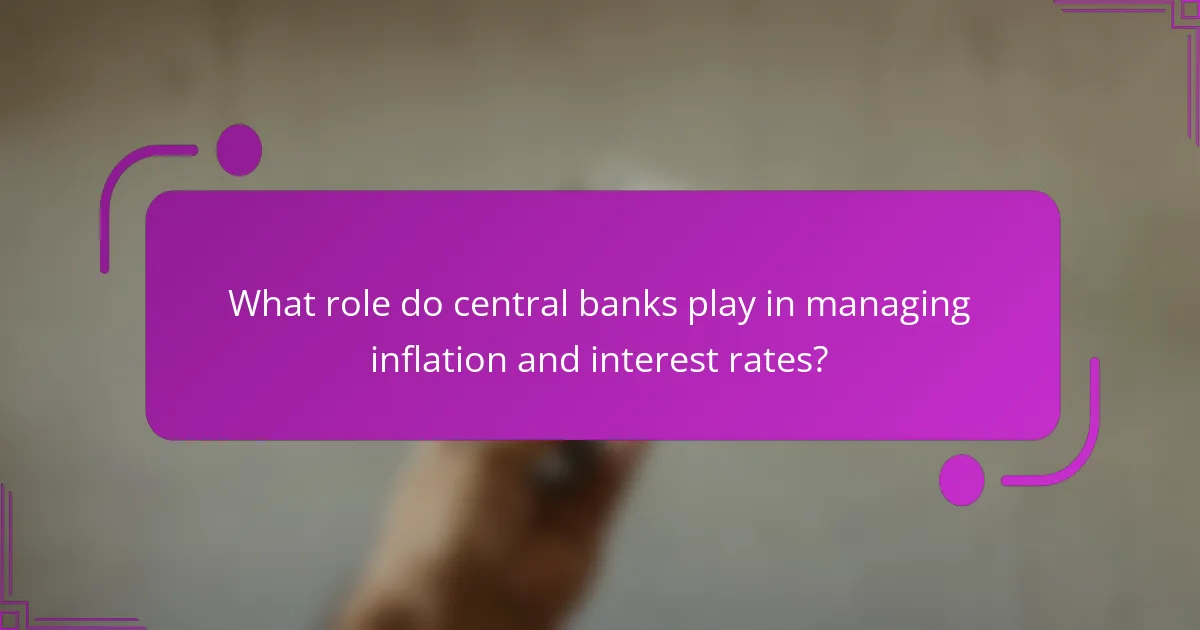
What role do central banks play in managing inflation and interest rates?
Central banks play a crucial role in managing inflation and interest rates by implementing monetary policy to influence economic activity. Their actions directly affect the availability of money and credit, which in turn impacts inflation rates and the real interest rates consumers and businesses face.
Adjusting monetary policy
Central banks adjust monetary policy primarily through open market operations, reserve requirements, and discount rates. By buying or selling government securities, they can increase or decrease the money supply, which influences inflation and interest rates. For example, increasing the money supply can lower interest rates, encouraging borrowing and spending.
When inflation rises above target levels, central banks may tighten monetary policy by reducing the money supply, which can lead to higher interest rates. This approach can help cool down an overheating economy but may also slow growth if applied too aggressively.
Setting interest rate targets
Central banks set interest rate targets to guide economic expectations and influence borrowing costs. By signaling their target rates, they can shape market behavior and stabilize inflation. For instance, if a central bank sets a lower target rate, it encourages lending and investment, which can stimulate economic growth.
Monitoring inflation indicators is essential for central banks when adjusting these targets. They often use tools like the Consumer Price Index (CPI) to gauge inflation trends and make informed decisions. A common practice is to adjust rates in response to projected inflation, aiming to keep it within a specific range, typically around 2% in many developed economies.

How do inflation expectations influence consumer behavior?
Inflation expectations significantly shape consumer behavior by affecting spending and saving decisions. When consumers anticipate rising prices, they are more likely to adjust their financial strategies to mitigate the impact of inflation on their purchasing power.
Changes in spending habits
As inflation expectations rise, consumers often shift their spending habits, prioritizing immediate purchases over future ones. This behavior can lead to increased demand for goods and services, potentially driving prices even higher. For example, if consumers expect prices to rise, they may buy durable goods sooner rather than later, impacting overall market dynamics.
Additionally, consumers might become more price-sensitive, seeking discounts and alternatives to maintain their purchasing power. This shift can lead to increased competition among retailers, influencing pricing strategies and promotional offers.
Impact on investment decisions
Inflation expectations can also affect how consumers approach investments. When inflation is anticipated, individuals may favor assets that traditionally outperform during inflationary periods, such as real estate or commodities. This shift can lead to increased investment in these areas, potentially driving up their prices.
Moreover, consumers may reconsider their savings strategies, opting for accounts or instruments that offer higher interest rates to counteract the eroding value of money. For instance, they might choose inflation-indexed bonds or high-yield savings accounts to protect their savings from inflation’s impact.
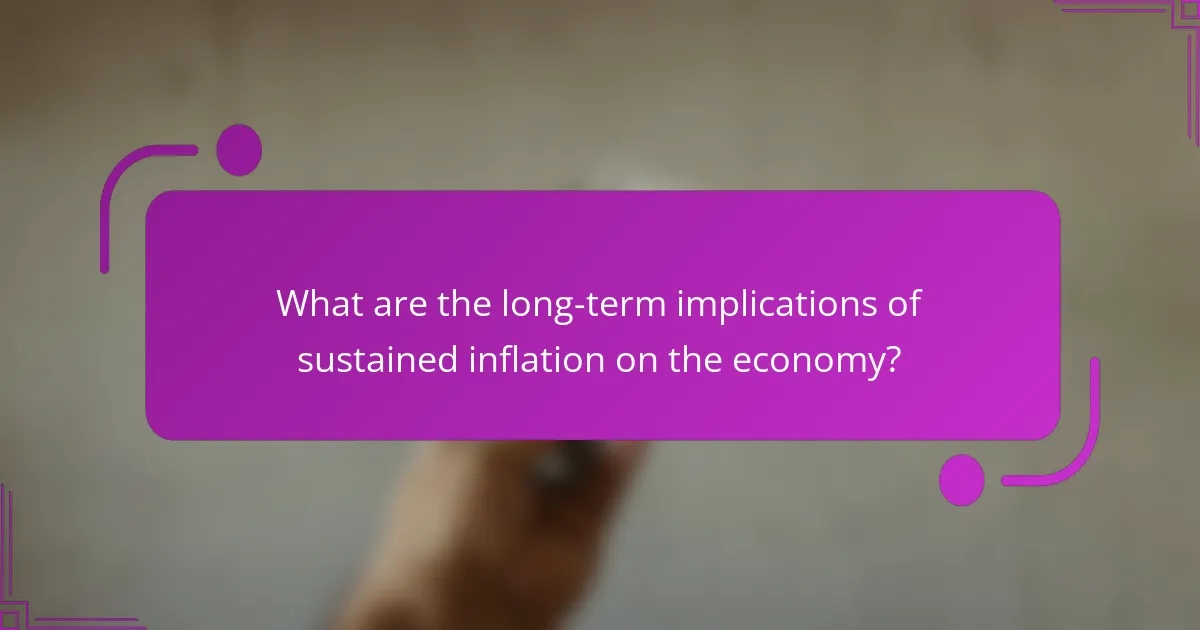
What are the long-term implications of sustained inflation on the economy?
Sustained inflation can lead to significant long-term effects on the economy, including reduced purchasing power and increased uncertainty for consumers and businesses. Over time, these factors can hinder economic growth and stability.
Potential for economic stagnation
When inflation remains high for an extended period, it can create an environment of economic stagnation. This occurs when rising prices outpace wage growth, limiting consumer spending and investment. As a result, businesses may struggle to expand, leading to lower economic output.
Stagnation can also lead to higher unemployment rates, as companies may cut back on hiring or even lay off workers to manage rising costs. This cycle can perpetuate a lack of economic dynamism, making recovery more challenging.
Effects on wage growth
Sustained inflation can adversely affect wage growth, as employers may be unable or unwilling to raise salaries in line with rising costs. When inflation exceeds wage increases, workers effectively experience a decrease in real income, impacting their standard of living.
In many cases, wage growth may lag behind inflation rates, creating a gap that can lead to employee dissatisfaction and reduced productivity. Workers may demand higher wages to keep up with living costs, but if businesses cannot accommodate these demands, it can result in labor disputes or increased turnover rates.
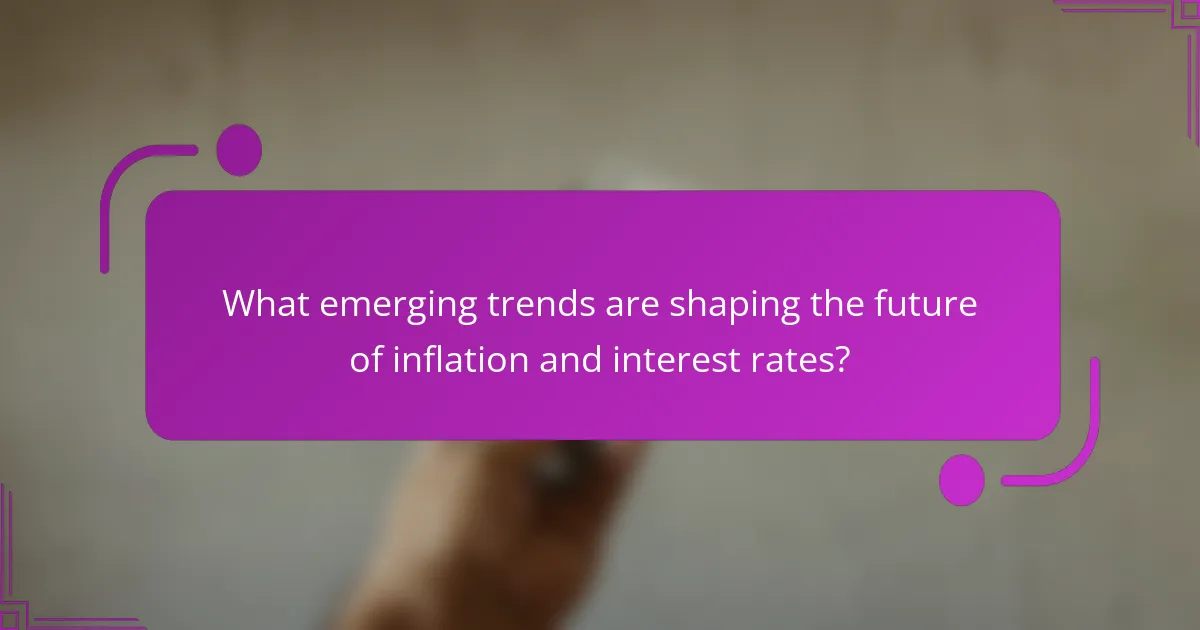
What emerging trends are shaping the future of inflation and interest rates?
Emerging trends such as digital currencies and shifts in monetary policy are significantly influencing inflation and interest rates. These factors can alter how savings are valued and impact overall economic stability.
Digital currencies and inflation
Digital currencies, including central bank digital currencies (CBDCs) and cryptocurrencies, are becoming increasingly relevant in discussions about inflation. Their introduction could lead to changes in how money supply is managed, potentially affecting inflation rates.
For instance, if a central bank issues a digital currency, it may allow for more direct control over monetary policy, which could stabilize or destabilize inflation depending on usage. Additionally, the decentralized nature of cryptocurrencies can create volatility, impacting traditional inflation measures.
Investors should consider the implications of digital currencies on their savings and investment strategies. Keeping an eye on regulatory developments and understanding how these currencies interact with existing financial systems will be crucial for making informed decisions.
